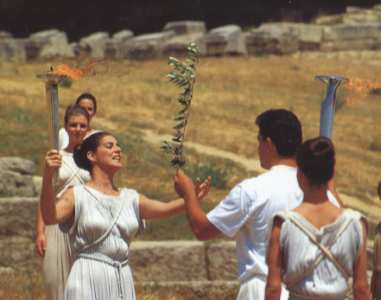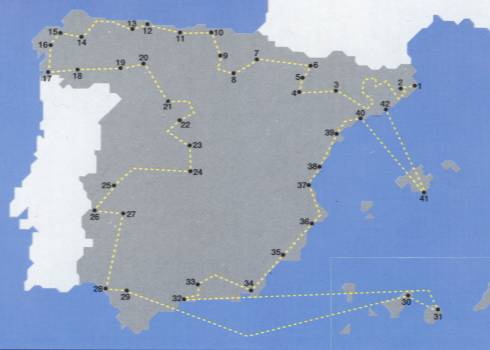Torch and Torch Relay
| The route and the association with companies
and institutions
On 1 January 1992, the COOB'92 Standing Committee approved the definitive route of the torch around Spain. A total of 5,940 kilometres had to be covered in 43 days, through all the Olympic subsites and the capitals of the autonomous communities (652 towns and cities altogether) without using the motorways. To speed up the pace on the longest and least populated sections, bicycle relays were introduced. They covered 1,490 kilometres and the remaining 4,450 were done on foot. The flame was taken from Sevilla to Tenerife and from Las Palmas to Málaga by plane; from Tenerife to Las Palmas by hydrofoil; and from Tarragona to Palma de Mallorca and from the island back to Barcelona by ship. 
The two kinds of the 1992 torch COOB'92 provided all the necessary resources for the route and organised the logistics (people, torches, uniforms, accommodation and catering services, vehicles, parking, maintenance and cleaning). It also supervised the design of the ceremonies held to welcome the flame in 60 different towns or cities. The whole operation was made possible by the contribution of three COOB'92 associate companies. SEAT provided the vehicles (including technical service and maintenance), the meeting points (78 company dealers) and the overnight parking spaces (41 of the dealers, where the vehicles were repaired, cleaned and refuelled). Mito (Induyco) brought the design, manufacture and distribution of the bearers' uniforms and the installation and management of the changing rooms. The runners' uniform consisted of a T-shirt, shorts, socks, trainers (supplied by ASICS) and a hairband. The cyclists wore a T-shirt and long latex trousers, socks, trainers and a safety helmet. Lastly, Coca- Cola took care of the accommodation and catering for the organisation and the supply of drinks for the convoy over the 43 stages. The company also worked on a project for international participation which was without precedent on any previous Olympic torch route: in association with the NOCs they selected 200 bearers from 50 countries, who also ran a relay of the Barcelona torch. But the cooperation of other institutions was also indispensable. The authorities of the autonomous communities made suggestions for the itineraries between cities and the landmarks which should be passed by along the way; they coordinated all the city councils on their territory and took part in selecting the bearers from the volunteers in each community. The city councils, in turn, took charge of the design of the route of the torch through their cities, the organisation of the welcoming ceremony and the overnight guardianship of the flame in the towns where it rested. |

|
|
The Paralympic archer Antonio Rebolle prepares to fire the arrow which will light the flame in the cauldron. |

| The relays and the bearers
Altogether there were 9,484 relays: 8,885 on foot and 599 on bicycles. The foot relays were 500 metres, which had to be covered in 3 minutes; the bicycle relays were 2,500 metres and the time 6 minutes. Only on the final lap, in Barcelona, were the foot relays shortened to 250 metres to give as many people as possible a chance to carry the torch. The bearers were selected by quotas: 50% had to be Olympic volunteers from around Spain; the councils of the towns the Olympic torch passed through had the right to choose a bearer; and, lastly, the companies which worked on the torch route and the other associate companies of COOB'92 had an opportunity to cover some of the relays. The remaining bearers were chosen from people who applied. They had to be over fifteen years old and promise to run the relay in the time available, to wear the official bearers' uniform and to observe the rules laid down by the organisation. The city councils and authorities of the autonomous communities the flame passed through took part in the selection. Each bearer carried a new torch, which was offered to them as a gift if they were volunteers; those who were not had an opportunity to buy it at cost price (15,000 pesetas). All of them received the uniform they had worn on their relay as a present from COOB'92. The bearers never ran alone; they were accompanied by an escort, whose job was to help them if they tired, felt unwell or stumbled and fell. The escorts did one relay as bearers and then accompanied nine more; on the foot relays, therefore, they ran 5 kilometres in 30 minutes and on the bicycle relays they rode 25 kilometres in 60 minutes. |
| Description: | "XXV Olympiad Barcelona 1992" legend and Barcelona emblem goldplated on stem. |
|---|---|
| Material: | Chrome-plated aluminum |
| Fuel: | Gas |
| Torch measure: | Lenght: 65 cm Weight: 1,200 gr |
| Torches total: | 6,500 |
| Design by: | André Ricard |
| Manufacturer: | Kromschröder |
| Date of the torch relay: | 5. June - 25. July 1992 |
| Duration: | 50 days |
| Numbers of runners: | 8,885 |
| Distance total: | 6,307 |
| Name of the last runner: | Juan Antonia San Epifanio |
Besides the escorts, the bearers had the support of a complex organisation. They gathered at a meeting point -the bearers' centre- where they were accredited, received the uniform, changed, handed in their clothes for safe-keeping and were given the torch. From there they were taken to the place where they were to start their relay. That point, which the bearers already knew -and therefore also their families and friends who wanted to watch and accompany them-, had been marked the previous day by the vanguard of the convoy with a sticker indicating the number of the relay. At the bearers' centres the journalists who wanted to have a place on the convoy press stand were also accredited, a total of 1,500 all along the route.
In groups of 40, the bearers were taken by bus from the bearers' centre to a point on the road where the convoy would pass by. They were then taken in groups of 10 to the starting point of their relays in minibuses which shuttled backwards and forwards to and from the convoy. On this journey the bearers received instructions and advice from monitors on how to run their relay. Once it was finished they were collected and taken back to the meeting point.
The escort and the bearer made up the heart of the torch convoy, which consisted of a total of 24 vehicles and 65 members of the organisation.
 The 1992 Barcelona Safty Lamp
The 1992 Barcelona Safty LampThe vehicles in the convoy were in four groups: route pilot, signposting and traffic control, nucleus and support/rearguard.
The route pilot vehicle was responsible for coordinating the transport of the bearers to and from the main convoy and seeing that the timetables were observed. The signposting and traffic control vehicles always travelled 500 metres ahead of the bearer and escort to slow down the traffic coming in the opposite direction and place the cones and flags which marked out the relays.
The vehicles which made up the nucleus were the ones which travelled immediately in front of and behind the bearer and the escort. The press platform (a vehicle specially designed for photographic coverage of the event) went just ahead of the bearer. Then came the convoy management vehicle which carried the safety lamp (containing an "original" Olympic flame to relight the torches if they went out accidentally) and the Red Cross vehicle. The rear of the convoy was brought up by the support and rearguard vehicles, among them the mobile changing
room, the catering vehicle, the services vehicle and the one for picking up the signposts and markers. Two mobile offices were installed at the hotels where the convoy stayed; the media services were located in one of them. Dinner and breakfast were always taken there and lunch too along some of the stages. Most frequently, however, lunch was eaten on the way or at the bearers' centres. The convoy functioned very well, as demonstrated by the success with the public of the entire itinerary of the Barcelona'92 torch. This aspect has already been covered in detail in Volume IV, Official Report 1992.
| Country | Date | Distance | Runners | Torches |
|---|---|---|---|---|
| Greece | 05.06. - 09.06.1992 | 367 km | ||
| Spanish frigate "Catalunya" |
09.06. - 13.06.1992 | km | ||
| Spain | 13.06. - 25.07.1992 | 5,940 km | ||
| Total | 6,307 km | 9,500 and 2,500 cyclists |
~ 6,500 |
|
The route The journey of the Olympic torch around the
17 autonomous communities of Spain started and finished in Catalonia. The
route passed through 652 different places and stopped in 60 towns. The
total distance - about 6,000 kilometres - was covered by 9,500 bearers
who ran relays on foot; for the longer stretches with greater distances
between built-up areas there were 2,500 relays on bicycles. Oddly enough,
the stretches which caused most problems with the schedule were the ones
covered by bicycle. 
Route of the torch around Spain
The Olympic flame lights up the Stadium After the celebration of the past, the Olympic torch entered thought the south gate borne by Herminio Menéndez, the Spanish athlete who had won most Olympic medals, and made one almost complete lap amidst the general emotion. Then one of the most jealously guarded screts of the opening ceremony was revealed: the basketball player Juan Antonio San Epifanio, "Epe", was awaiting the flame in front of the grandstand to run the last relay. Beside the Marathon gate, the Olympic archer waited with the arrow with which he had to light the cauldron atop the Stadium. At that moment, the audience, in unison, lit the flares which tew were supposed to keep for the European anthem at the end of the ceremony. With this gesture, a host of blue and yellow lights swaying in harmony accompanied the last relay of the torch to the stage. For the first time at the Games, an archer would ignite the fire which would preside day and night from the cauldron over the competitions with a flaming arrow. The torch carried by the last bearer touched the arrow and the archer, Antonio Rebollo, a Paralympic athlete, prepared to shoot with the precision which characterises one of the most ancient Olympic sports. The arrow described an arc an lit the gas
issuing from the cauldron; the flame soared up to a height of three metres.
The most eagerly awaited moment of the ceremony had come and gone to general
acclamation. (Source document: Official
Report 1992, Vol. III, page 35 and Vol. IV) |